1 IoT network architecture
The IoT networking uses a layered communication system architecture, including a perceptual extension system, a transmission system, a business operations management system, and various applications, supporting different communication protocols at different levels, as shown in Figure 1. The perceptual extension system includes sensing and control technologies, consisting of perceptual extension layer devices and gateways, and supports multiple perceptual extension networks including communication protocols such as Lonworks, UPnP, and Zigbee. The sensing device can connect to the core network through multiple access technologies to realize remote transmission of data. The business operations management system is oriented to energy-consuming facilities within the Internet of Things, including application systems and business management support systems. The application system provides end users with metrology statistics, remote measurement and control, intelligent linkage, and other extended types of services. The business management support system implements functions such as user management, security, authentication, authorization, and accounting.
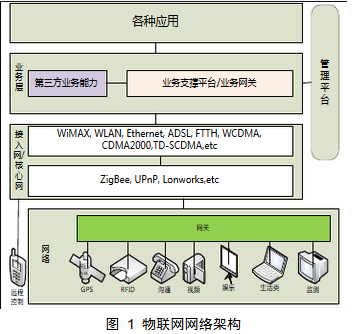
2 IoT Gateway Hierarchy
The IoT gateway supports multiple communication protocols and data types between the sensing extension devices, implements the conversion of data communication formats between multiple sensing extension devices, unifies the uploaded data formats, and simultaneously achieves the acquisition of the perceptual extended network. Control commands are mapped to produce messages that conform to the specific device communication protocol. The IoT gateway performs unified control and management on the perceptual extension device, and shields the heterogeneity of the underlying perceptual extension network to the upper layer. It is divided into four layers, which are the service service layer, the standard message composition layer, the protocol adaptation layer and the perceptual extension layer. ,as shown in picture 2.

2.1 Business Service Layer
It consists of a message receiving module and a message sending module. The message receiving module is responsible for receiving standard messages from the IoT business operations management system and passing the messages to the standard message composition layer. The message sending module is responsible for reliably transmitting the data information collected by the sensing extension network to the business operation management system. Messages received and sent by this layer must conform to the standard message format.
2.2 Standard message composition layer
It consists of a message parsing module and a message conversion module. The message parsing module parses the standard message from the business service layer, and invokes the message conversion module to convert the standard message into a data format that is understandable by the underlying perceptual extension device and that is dependent on the specific device communication protocol. When the extension layer uploads data, the message parsing module of the layer parses the message that depends on the specific device communication protocol, and invokes the message conversion module to convert it into a message in a standard format that the service layer can receive. The message composition layer is the core of the IoT gateway. It completes the parsing of standard messages and messages that depend on a specific perceptual extended network, and realizes the mutual conversion between the two to achieve unified control and management of the underlying perceptual extension network, shielding the underlying network upwards. The purpose of the heterogeneity of communication protocols.
2.3 Protocol Adaptation Layer
The protocol adaptation layer ensures that different perceptual extension layer protocols can become formatted data and control signaling through this layer.
2.4 Perceptual extension layer
This layer is oriented to the underlying sensing extension device and includes two sub-modules: message sending and message receiving. The message sending module is responsible for transmitting the message that can be understood by the specific perceptual extension device after the message composition layer is converted to the underlying device. The message receiving module receives the message from the underlying device and sends it to the standard message composition layer for parsing. The Perceptual Extended Network consists of sensing devices, including RFID, GPS, video surveillance systems, and various types of sensors. Perceptual extension devices support multiple communication protocols and can form Lonworks and Zigbee as well as a variety of other perceptual extension networks.

Figure 3 shows the information exchange process in the Internet of Things. It can be seen that the IoT gateway solves the problem that different devices in the IoT network cannot be uniformly controlled and managed, and the purpose of shielding the underlying communication differences is achieved, and the end user does not need to know the underlying device. The specific communication details enable unified access to different perceptual extension layer devices.
3 IoT Gateway Design
3.1 Hardware Structure
The overall structure of the gateway is shown in Figure 4. The data acquisition module implements the collection or aggregation of physical world data. It can be the aggregation node of the sensor network, the reader of the RFID network, the video acquisition device, and the GPS. The processing/storage module is the core module of the gateway, which implements data processing and storage in various aspects such as protocol conversion, management, and security. The access module connects the gateway to the WAN. Possible methods include wired (Ethernet, ADSL, FTT, etc.), wireless (WLAN, GPRS, 3G, satellite, etc.). The power supply module is responsible for powering the gateway. Possible power supply methods include utility power, solar energy, and storage batteries.
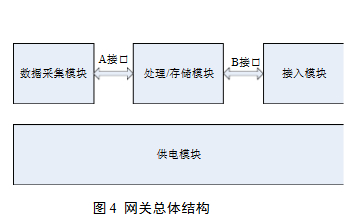
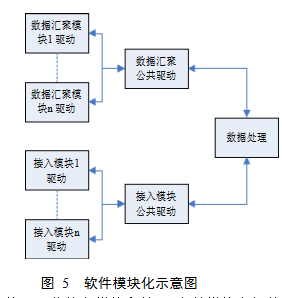
Here, the interface between the data collection module and the processing/storage module is referred to as an A interface, and the interface between the access module and the processing/storage module is referred to as a B interface. Types of A interface may have UART (the most used way), RS232/RS485 (such as various instruments, meters), SPI (for direct operation of short-range RF modules), USB (video head), Ethernet, AD Bus, etc.; type of B interface may have UART, USB, AD bus, etc. It is necessary to gradually define the specifications and standards of the A interface and the B interface in the development process.
3.2 Software Structure
The design of the gateway is to implement various parts of the hardware and software in a modular way, making the replacement between modules very easy. The hardware modules are connected in a bus form (such as UART, USB, PCI, local bus, etc.), and the software is run in a modular loadable manner, and the common parts are abstracted into a common module, as shown in FIG. Therefore, supporting new data aggregation modules and access modules requires only the development of corresponding hardware modules and drivers. In addition, the data in the process is unified, and the load part is organized by TLV (Type, Length, Value), as shown in FIG. 6.
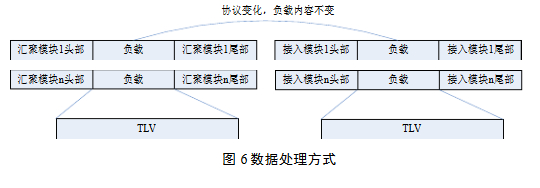
4 IoT Gateway DEMO Edition
The overall structure of the DEMO system that needs to be developed at present is shown in Figure 7. The wireless sensor node collects information such as temperature in the environment, and sends data to the gateway through wireless multi-hop self-organizing mode. The fixed reader reads the RFID tag content and sends it to the gateway. The gateway sends the data to the server over the WCDMA network; the server processes and stores the data and provides an information platform for users (including PC users and mobile phone users) to use. By implementing this DEMO system, it is possible to study key technologies related to the Internet of Things.
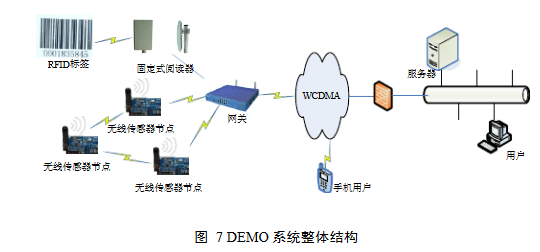
4.1 Hardware components
1. RFID tag: The RFID tag is selected for card type, which is convenient for presentation.
2. Fixed reader: The fixed reader selects a serial reader with low price and only ordinary read/write card function.
3 Wireless sensor nodes: Wireless sensor nodes use nodes that currently support the IEEE 802.15.4 standard and can support ZigBee and 6LoWPAN protocols.
4.2 System Structure
The gateway structure of the DEMO system is shown in Figure 8. The fixed reader and the wireless sensor node communicate with the processing module via RS232, and the WCDMA communication module communicates with the processing module via USB.
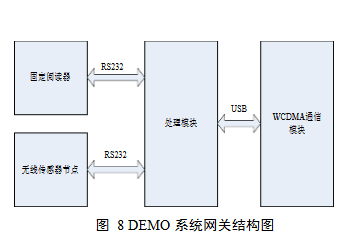
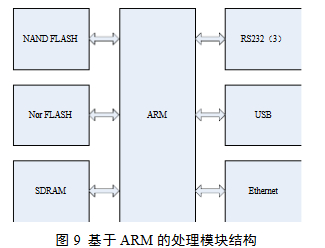
Figure 9 ARM-based processing module structure processing module Currently considers two implementation methods: (1), using PC as the processing module (2), using ARM processor to implement the processing module, its hardware structure is shown in Figure 9. The server can use an office PC.
4.3 Software composition
1. Wireless Sensor Node Software The wireless sensor node software is developed based on single-chip microcomputer and C language, and can be completed quickly on the basis of the code of the purchased wireless sensor node.
2. Gateway software gateway software is developed using Linux operating system, and its software structure is shown in Figure 10. The bottom layer is the driver for each hardware, and applications such as protocol conversion and configuration management are implemented in the application.
The functions that need to be implemented include: wireless sensor network and protocol conversion between RFID network and WCDMA network. The main consideration here is packet organization and conversion between networks;
Configuration management: You can configure the gateway by using several methods: Console, Telnet, or Web.
3. Server software
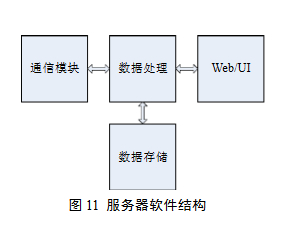
The structure of the server software is shown in Figure 11. The communication module is responsible for sending and receiving data, and the data processing is responsible for grouping the data generated by the Web/UI or unpacking the received data into the database.
5 Conclusion
IoT gateways play a key role in the Internet of Things. This paper aims to study a heterogeneous gateway device that can support various sensor networks and access networks. It can support different types of sensor nodes (wireless such as ZigBee, 6LoWPAN, etc., wired such as RS485, CAN, etc.) and access methods. (such as wired, WLAN, GPRS, 3G, etc.), and can provide a unified data format for middleware or applications, so as to shield different sensor networks and access networks for applications, so that applications only need to focus on the data of the application environment. deal with. In the research of IoT gateway, the next step will integrate firewall, VPN, DoS, traffic management, IPS, IDS, online behavior management, content filtering, WEB security, anti-virus, anti-spam and other functional modules, which can meet various aspects. The need for protection, so as to truly achieve a three-dimensional guarantee of business security.
Array Speakers,Waterproof Loudspeaker,Line Array Speaker,Linear Array Loudspeaker
NINGBO SANCO ELECTRONICS CO., LTD. , https://www.sancobuzzer.com